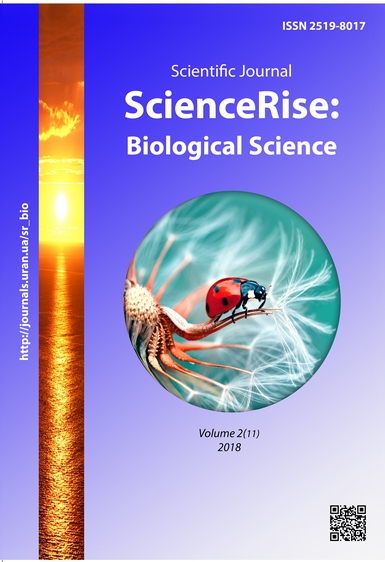Ontogenetic population analysis of rare species Lilium Martagon L. in the structure of ecological network of Vinnytsia region
DOI:
https://doi.org/10.15587/2519-8025.2018.129700Keywords:
population, Lilium martagon L., ontogenetic structure, rare species, ecological network, connecting territoriesAbstract
According to the results of the research on phytomagnification of the connecting territories of the ecological network of Vinnytsia region, the distribution of rare and endangered species of higher vascular plants, which characterize the value of these territories, is determined. An ontogenetic-populational analysis of the state of cenopopulations was carried out on an example of the rare species Lilium martagon L. This species is a model for the studied phytocoenoses of the connecting territories of ecocorridors of the national (South-Bug, Dnestrovsky), regional (Lyadovsky, Nemiisky) levels. The ontogenetic spectra of investigated L. martagon L. populations were constructed and analyzed for their belonging to one of four types: left-sided, centered, right-handed, bimodal. It is determined that they belong to incomplete ones, with the prevalence of the right-hand spectrum. The integral estimation of the population condition is carried out using the ontogenetic indices of I. M. Kovalenko (indices of regeneration, aging, generative and age). The index of age-old AA Uranov - Δ, index of efficiency of L.V. Zhivotovsky - ω is calculated. The affiliation of each of the studied populations to a certain type of ontogenetic structure of populations according to the classifications by TA O. Rabotnova (invasive, normal, regressive) and LV Zhivotovsky (young, transitional, dying, mature, aging, old) are determined. According to the results of the conducted research, it has been established that L. martagon L. populations are characterized as normal with subsequent transformation into regression. On the basis of the obtained results, conclusions are made on the ontogenetic structure of model populations of the rare species L. martagon L
References
- Hryhora, I. M., Solomakha, V. A. (2000). Basic of phytocenology. Kyiv: Phytosociocentr, 239.
- Mudrak, O. V. (2012). The balanced development of Podillya ecological network: status, problems, prospects. Vinnytsia: A sublect of economical activity "Glavatskaya R.V.", 914.
- Tkach, Е. D., Sherstoboieva, O. V., Shavrina, V. I., Starodub, V. I., Dovhych, K. I., Honcharenko, H. Ie. et. al. (2015). Fitobiotychne riznomanittia pryrodnykh fitotsenoziv ahrolandshaftiv Ukrainy [Phytobiotic diversity of natural phytocoenoses of Ukraine's agricultural landscapes]. Kyiv, 231.
- Didukh, Ya. P. (Ed.) (2009). Red Book of Ukraine. Flora. Kyiv, Hlobalkonsaltynh, 900.
- Didukh, Ya. P., Pliuta, P. H. (1994). The phytoindication ecological factors. Kyiv: Naukova dumka, 280.
- Shavrina, V., Tkach, E. (2017). Rare plants of ecological network in connecting areas of Vinnytsia region. Agroecological journal, 1, 115–120.
- Melnyk, V. І. (2000). Redkye vydi flori ravninnikh lesov Ukrayny [Rare species of the flora of the plain forest of Ukraine]. Kyiv: Fitosotsiotsentr, 104–107.
- Zlobin, Yu. A., Sklyar, V. G., Klimenko, A. A. (2009). Populatsciinaia ecologia rastenii: sostoianiie tochki rosta [Population Ecology of plants: current status in national ecosystems]. Kyiv: Naukova Dumka, 439.
- Andersen, E, Baldock, D., Bennett, H., Beaufoy, G., Bignal. E., Brouwer, F. et. al. (2003). Developing a High Nature Value Indicator. Report for the European Environment Agency. Copenhagen.
- Sheliah-Sosonko, Yu. R. (Ed.) (2004). Formuvannia rehionalnykh skhem ekomerezh [Formation of regional schemes of eco-networks]. Kyiv: Fitotsentr, 71.
- Sherstoboieva, O. V., Tkach, Ye. D., Starodub, V. I., Dovhych, K. I., Shavrina, V. I., Bohoslovska, M. S. (2012). Assessment of anthropogenically transformed phytocoenoses of agrolandscapes in Ukraine. Kyiv, 24.
- Tkach, Ye. D., Sherstoboieva, O. V., Kryzhanivskyi, A. B., Starodub, V. I., Shavrina, V. I., Lobova, O. V. (2017). Scientific and methodological bases of estimation of agrophytocenoses in conditions of climate change. Kyiv, 52.
- Didukh, Ya. P., Shelyagh-Sosonko, Yu. R. (2003). Geobotanical zonation of Ukraine and the adjascent territories. Ukrainian Botanical Journal, 60 (1), 6–17.
- Rabotnov, T. A. (1984). Luhovedenye [Meadow studies]. Moscow: Mos. Un-t, 320.
- Uranov, A. A. (1975). Age spectrum of phytocenopopulations as a function of time and energy wave processes. Nauchnye doklady vysshey shkoly. Biologicheskie nauki, 2, 7–34.
- Zhivotovsky, L. A. (2001). Ontogenetic states, effective density and classification of plant populations. Ecology, 1, 3–7.
Downloads
Published
How to Cite
Issue
Section
License
Copyright (c) 2018 Vira Shavrina, Evheniia Tkach

This work is licensed under a Creative Commons Attribution 4.0 International License.
Our journal abides by the Creative Commons CC BY copyright rights and permissions for open access journals.
Authors, who are published in this journal, agree to the following conditions:
1. The authors reserve the right to authorship of the work and pass the first publication right of this work to the journal under the terms of a Creative Commons CC BY, which allows others to freely distribute the published research with the obligatory reference to the authors of the original work and the first publication of the work in this journal.
2. The authors have the right to conclude separate supplement agreements that relate to non-exclusive work distribution in the form in which it has been published by the journal (for example, to upload the work to the online storage of the journal or publish it as part of a monograph), provided that the reference to the first publication of the work in this journal is included.









